Market Share
Southeast Asia Electric Bike Market Share Analysis
In the dynamic landscape of the Southeast Asia Electric Bike Market, companies employ various strategies to position themselves favorably and capture market share. One prevalent approach is differentiation, where companies strive to distinguish their electric bikes from competitors' offerings. This could involve emphasizing unique features such as superior battery life, innovative designs, or advanced safety features. By standing out in the market, companies can attract consumers seeking specific benefits or qualities in their electric bikes.
Moreover, pricing strategies play a pivotal role in market share positioning. Some companies opt for a penetration pricing strategy, setting prices lower than competitors to quickly gain traction and market share. This approach can be particularly effective in price-sensitive markets within Southeast Asia, where affordability is a significant factor influencing purchasing decisions. Conversely, other companies may adopt a premium pricing strategy, positioning their electric bikes as high-end products with superior quality or performance. While this may limit initial market penetration, it can lead to higher profit margins and a more exclusive brand image.
Distribution channels also play a crucial role in market share positioning within the Southeast Asia Electric Bike Market. Companies may choose to focus on expanding their presence in key retail outlets or partner with e-commerce platforms to reach a wider audience. Additionally, establishing strategic partnerships with local distributors or bike shops can enhance accessibility and brand visibility in specific regions. By leveraging multiple distribution channels effectively, companies can increase their market reach and compete more effectively against rivals.
Furthermore, marketing and branding efforts are essential components of market share positioning strategies. Companies invest in advertising campaigns, social media marketing, and influencer partnerships to build brand awareness and generate consumer interest in their electric bikes. Creating a strong brand identity that resonates with target customers can help companies differentiate themselves and cultivate brand loyalty over time. Additionally, offering promotions, discounts, or loyalty programs can incentivize consumers to choose a particular brand over competitors, further solidifying market share.
Product innovation and continuous improvement are also critical for maintaining a competitive edge in the Southeast Asia Electric Bike Market. Companies invest in research and development to introduce new features, technologies, and designs that meet evolving consumer preferences and market trends. By regularly updating their product offerings and staying ahead of the competition, companies can attract new customers and retain existing ones, thereby strengthening their market position.
Lastly, customer service and after-sales support are integral components of market share positioning strategies. Providing excellent customer service, timely maintenance, and warranty support can enhance brand reputation and foster positive word-of-mouth recommendations. Satisfied customers are more likely to become repeat buyers and advocates for the brand, contributing to long-term success and market leadership in the Southeast Asia Electric Bike Market.
In conclusion, market share positioning in the Southeast Asia Electric Bike Market involves a multifaceted approach encompassing differentiation, pricing strategies, distribution channels, marketing and branding, product innovation, and customer service. By effectively executing these strategies, companies can carve out a distinctive market presence, attract customers, and gain a competitive advantage in this rapidly growing industry.





Leave a Comment